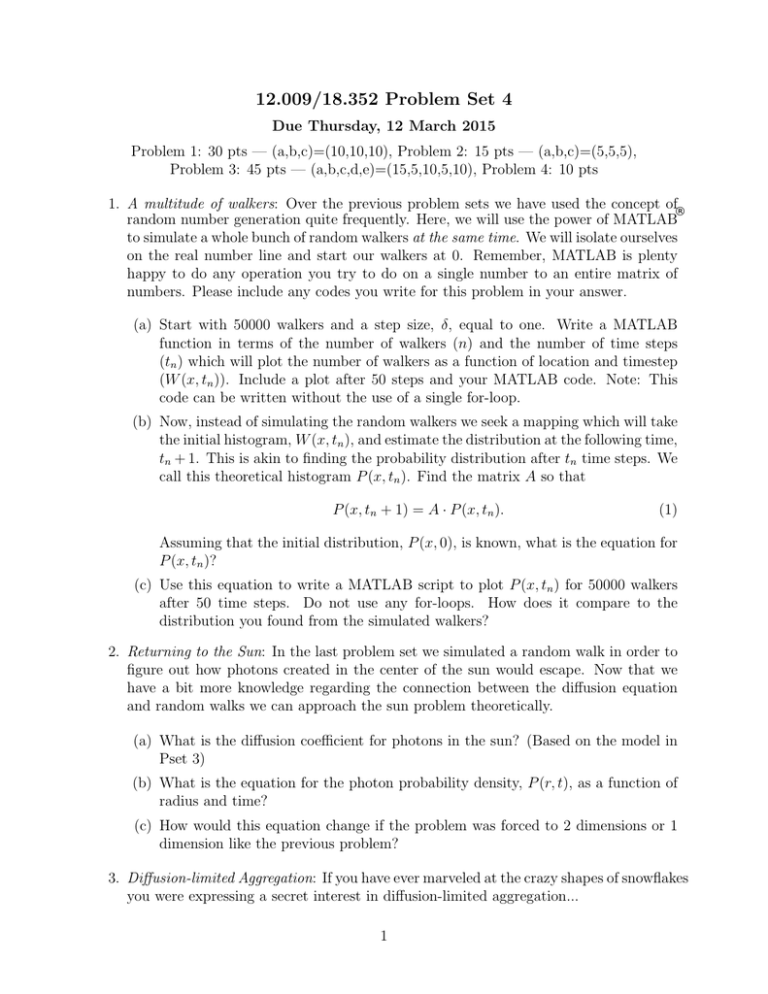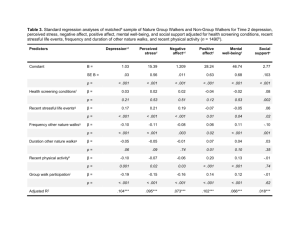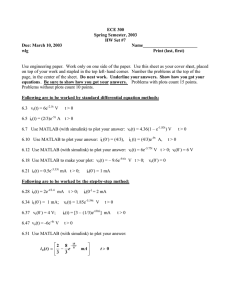Problem Set 4 12.009/18.352
advertisement

12.009/18.352 Problem Set 4 Due Thursday, 12 March 2015 Problem 1: 30 pts — (a,b,c)=(10,10,10), Problem 2: 15 pts — (a,b,c)=(5,5,5), Problem 3: 45 pts — (a,b,c,d,e)=(15,5,10,5,10), Problem 4: 10 pts 1. A multitude of walkers: Over the previous problem sets we have used the concept of random number generation quite frequently. Here, we will use the power of MATLAB to simulate a whole bunch of random walkers at the same time. We will isolate ourselves on the real number line and start our walkers at 0. Remember, MATLAB is plenty happy to do any operation you try to do on a single number to an entire matrix of numbers. Please include any codes you write for this problem in your answer. (a) Start with 50000 walkers and a step size, δ, equal to one. Write a MATLAB function in terms of the number of walkers (n) and the number of time steps (tn ) which will plot the number of walkers as a function of location and timestep (W (x, tn )). Include a plot after 50 steps and your MATLAB code. Note: This code can be written without the use of a single for-loop. (b) Now, instead of simulating the random walkers we seek a mapping which will take the initial histogram, W (x, tn ), and estimate the distribution at the following time, tn + 1. This is akin to finding the probability distribution after tn time steps. We call this theoretical histogram P (x, tn ). Find the matrix A so that P (x, tn + 1) = A · P (x, tn ). (1) Assuming that the initial distribution, P (x, 0), is known, what is the equation for P (x, tn )? (c) Use this equation to write a MATLAB script to plot P (x, tn ) for 50000 walkers after 50 time steps. Do not use any for-loops. How does it compare to the distribution you found from the simulated walkers? 2. Returning to the Sun: In the last problem set we simulated a random walk in order to figure out how photons created in the center of the sun would escape. Now that we have a bit more knowledge regarding the connection between the diffusion equation and random walks we can approach the sun problem theoretically. (a) What is the diffusion coefficient for photons in the sun? (Based on the model in Pset 3) (b) What is the equation for the photon probability density, P (r, t), as a function of radius and time? (c) How would this equation change if the problem was forced to 2 dimensions or 1 dimension like the previous problem? 3. Diffusion-limited Aggregation: If you have ever marveled at the crazy shapes of snowflakes you were expressing a secret interest in diffusion-limited aggregation... 1 Imagine that we have a field surrounded by pubs. To increase safety, the local park commission installed a street lamp in the middle of the field. Now, every night at 2am drunk people stumble out of the bar and go on a random walk until they smack into the pole, fall down, and fall asleep. The next person repeats the same process, either hitting the pole, or one of their drunk brethren. After a while the view from the air looks something like this 20 30 40 50 60 70 30 40 50 60 70 80 Image by MIT OpenCourseWare. where the bright dots are the drunk people and the pole is at the (51, 51) mark. This is not only a nice way to think about it, but this process is also how many natural aggregating systems work. (a) Use MATLAB to simulate diffusion-limited aggregation. Start with a sticky spot in the center of your domain and let random walkers in from the outside until they find the aggregate. Start with a square lattice 101 by 101 units square and let in 200 walkers, one at a time. Make sure you wait until they stick before releasing the next one. Also, we recommend not allowing your walkers to leave the ‘field’. Submit your code. (b) Make a plot of your aggregate. You may find the image function in MATLAB useful. (c) Make a plot of the mass of the aggregate contained in a circle of radius r as a function of r. How does the mass scale with the radius? (d) Suppose that instead of sticking to their brethren, the drunks fall asleep after a characteristic time τ (remember that they are trapped in the field). How long must τ be so that the sleeping drunks are randomly distributed across the entire field? How would the number of sleeping drunks in this case scale with the radius from the pole? (e) What causes this disparity in scaling between the random sleepers and diffusionlimited aggregation? 4. Make Your Own River Network: Use MATLAB to draw a river network based on the directed random walk ideas of Scheidegger as detailed in class. Please submit your code and a plot, and make the network at least 30x30 in size, but still visible. You may find the quiver function useful. 2 MIT OpenCourseWare http://ocw.mit.edu 12.009J / 18.352J Theoretical Environmental Analysis Spring 2015 For information about citing these materials or our Terms of Use, visit: http://ocw.mit.edu/terms.






